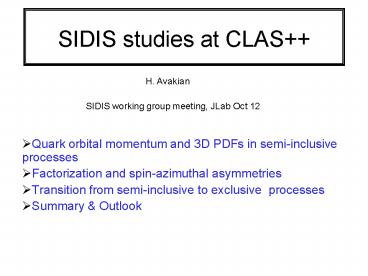SIDIS studies at CLAS - PowerPoint PPT Presentation
Title:
SIDIS studies at CLAS
Description:
study the transition between the nonperturbative and perturbative regimes of QCD ... x dependence of CLAS A1p (A2=0) consistent with HERMES data and factorization. ... – PowerPoint PPT presentation
Number of Views:31
Avg rating:3.0/5.0
Title: SIDIS studies at CLAS
1
SIDIS studies at CLAS
H. Avakian
SIDIS working group meeting, JLab Oct 12
- Quark orbital momentum and 3D PDFs in
semi-inclusive processes - Factorization and spin-azimuthal asymmetries
- Transition from semi-inclusive to exclusive
processes - Summary Outlook
2
Semi-inclusive DIS at JLab
X.Ji
- study the transition between the nonperturbative
and perturbative regimes of QCD - test factorization and measure higher twists
- Identify the limits of the partonic description
Main focus of SIDIS studies
- orbital angular momentum of quarks
- parton distributions at large x
3
Transverse momentum of quarks
- kT crucial for orbital momentum and spin
structure studies - lead to SSA in hard scattering processes
- kT lead to 3 dimensional description
- lead to introduction of kT dependent PDFs
- kT - important for cross section description
(important also for exclusive production) - PT distributions of hadrons in DIS
- exclusive photon production (DVCS)
- - hard exclusive vector meson x-section
- - pp ? p0X (E704,RHIC) x-sections
4
SIDIS studies require
- Factorization in SIDIS into a distribution
function f (x) fragmentation function D(z) and
hard scattering part. - Universality of distribution and fragmentation
functions - (SIDIS,DY,ee-)
- Applicability of partonic description at JLab
energies - Low W and Q2
- Low MX in ep-gtehX
- Control over background processes
- Resonances in the t-channel
- Exclusive vector mesons
5
SIDIS factorization
SIDIS (gp-gtpX) x-section at leading twist
Ji et al.
Structure functions FUU,FLL factorize into TMD
distributions (hep-ph 0405085)
P- has contributions from distribution,
fragmentation and soft gluon radiation
6
Factorization in SIDIS
Twist-2 TMDs from Mulders et al
FSI from Brodsky et al. used in gauge invariant
definition of TMDs by Collins, Ji et al. 2002
Studies of TMDs require three experiments (also
planed for exclusive processes)
1) Unpolarized target 2) Transversely pol.
target 3) Longitudinally pol. target
7
Multiplicities and Factorization
DIS Q2gt1 W2gt4 MXgt1.1 (1.4) ylt0.85
Dup KKP (LO)
No significant variation observed in z
distributions of p for different x ranges
8
A1p shows no significant Q2 and z dependence
ep ? e p X ( Ee 5.7 GeV, MX gt 1.1)
0.4ltzlt0.7
- x dependence of CLAS A1p (A20) consistent with
HERMES data and factorization. - No z-dependence of A1p observed above z0.4
9
PT-dependence
MC
DATA
corrected for ltxgt
A1p for Egt5GeV doesnt show significant PT
dependence
Asymmetries from kT-odd (f1-, h1-, gT..) and
kT-even (g1) distribution functions are expected
to have a very different behavior
10
SSA PT-dependence of sinf moment
ssinfLU FLUHLT 1/Q (Twist-3)
CLAS _at_5.7 GeV
CLAS _at_4.3 GeV
Beam and target SSA are consistent with increase
with PT
11
Transverse Target SSA at CLAS _at_11 GeV
CLAS _at_ 11GeV
Collins
AUT
Sivers
AUT
Sivers effect at CLAS kinematically enhanced
Simultaneous measurement of SIDIS, exclusive
r,r,w and DVCS asymmetries with a transversely
polarized target.
12
Double spin asymmetries with transverse target
L.Gamberg et al. Phys.Lett.B584276-284,2004
access gT and its PT-dependence
6 GeV
negligible
12 GeV
27.5 GeV
13
Longitudinally polarized Target SSA for p at
11GeV
Measurement of kT dependent twist-2 distribution
will check the existence of the Collins
fragmentation.
- Study the PT dependence of AULsin2f
- Study the possible effect of large unfavored
Collins function.
Efremov et al.
14
ALU x-dependence CLAS _at_ 4.3 and 5.7 GeV
0.5ltzlt0.8
Beam SSA analyzed in terms of the Collins effect
by Schweitzer et al. using e(x) from cQSM
Separation of different HT contribution will
require independent measurements of separate
contributions
15
Target SSA sinf moment (HERMES effect)
At least 3 possible contributions to study
- First measurement of non-0 effect on p-
- SSA consistent with HERMES
16
AUL as a function of MX for p
Phys.Lett.B53585-92,2002
HERMES
Semi-inclusive AUL has the same sign
Measurements of semi-exclusive SSA is important
to control corrections
17
p SSA from r(pp-/pp0)
Modulation exist even for vanishing helicity
change amplitudes
PYTHIA at 5.7 GeV
(CLAS _at_5.7GeV)
r0
Larger fraction of p from r at low x and large z
p SSA at large z may also have a significant
(20) contribution from r
18
Summary
- CLAS at 12 GeV can make a major contribution in
studies of the quark orbital momentum and parton
distributions at large x - For a complete set of data all 3 types of
targets in electroproduction experiments needed
(with proton and deuteron) - Unpolarized year 1
- Transversely polarized year 2
- Longitudinally polarized year 3
- Precision measurement of 3D parton distribution
functions will require separation of
contributions from different mechanisms and
global analysis of SSAs for exclusive and
semi-inclusive final states.
19
Energy dependence in SIDIS
sUU
Unpolarized Longitudinally polarized Transveresl
y polarized
sLL
sUT
Collins
Kinematic pre-factors depend on the beam energy
yn/E
20
Exclusive pp- and pp0
e p e p ?
p p-
n
r
r0
r0 PID by Mpp and missing p-
r PID by Mpp and missing neutron
Fit Mpp with a BW polinomial background.
21
0.1
22
PT-dependence
EG2000 DATA
A1p for Egt5GeV doesnt show significant PT
dependence on z range
23
Main focus of spin physics
- Parton distributions
- Orbital angular momentum
- Gluon polarization
JLab at 12 GeV can make a major contribution in
first two !!!































